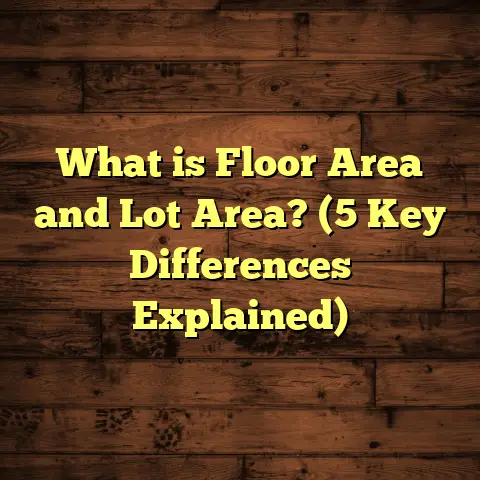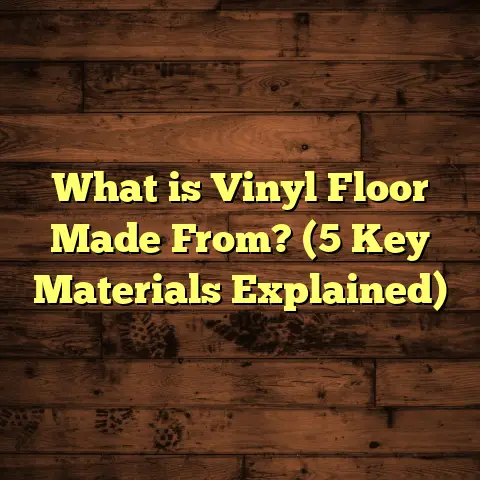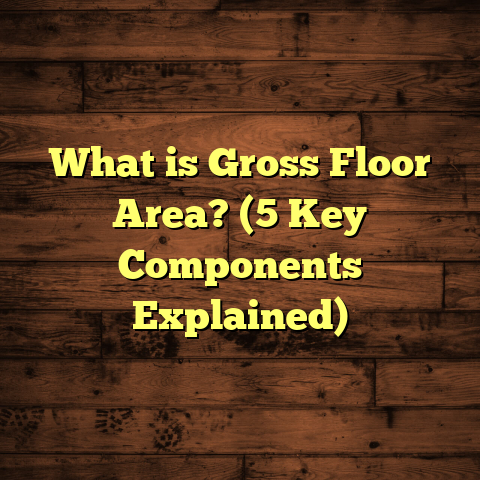What is Moisture Sensitive Flooring? (5 Key Benefits Explained)
Timelessness is something I often think about when it comes to flooring. Floors are the foundation of any home’s aesthetic and functionality, and choosing the right type can mean the difference
between a space that ages gracefully and one that struggles with wear and tear. Over the years, I’ve noticed a growing interest in moisture sensitive flooring, especially among homeowners who want both durability and style without constant worry about water damage or warping. So, what exactly is moisture sensitive flooring? Let me walk you through it.
What is Moisture Sensitive Flooring?
Moisture sensitive flooring refers to flooring materials
that react negatively when exposed to water, high humidity, or damp environments. These floors can warp, swell, buckle, or develop mold if moisture penetrates them. Common examples include hardwood, laminate, and certain types of engineered wood floors.
The sensitivity stems from the organic materials in these floors — wood fibers and adhesives — which absorb moisture and expand or degrade over time. This is why installing and maintaining these floors requires careful attention to the moisture levels in your home.
From my experience, understanding the nature of moisture sensitive flooring is vital before deciding if it fits your lifestyle or space. For instance, hardwood floors are beautiful but highly prone to moisture issues if installed in basements or bathrooms without proper moisture barriers.
Types of Moisture Sensitive Flooring
It’s helpful to break down the most common moisture sensitive floors to understand how they differ:
- Solid Hardwood: Made of solid wood planks. Very sensitive to moisture because wood expands/contracts as it absorbs water.
- Engineered Hardwood: Multiple layers with a hardwood veneer on top. More stable than solid wood but still moisture sensitive due to wood content.
- Laminate Flooring: Composed of fiberboard core with a photographic wood pattern laminated on top. Highly vulnerable to moisture because fiberboard swells when wet.
- Cork Flooring: Natural cork tiles or planks are also sensitive to moisture and need protection.
Each type requires tailored installation and maintenance strategies to minimize water damage risk.
Why Does Moisture Sensitivity Matter?
You might be wondering why this matters so much. Here’s the thing: moisture is one of the biggest enemies of many flooring types. It can lead to:
- Warping and Buckling: Floors lose their shape and lift up.
- Swelling: Boards expand unevenly, causing gaps or cracks.
- Mold and Mildew Growth: Moisture trapped under floors can foster harmful mold.
- Adhesive Failure: Glue can break down, leading to loose planks.
- Discoloration and Staining: Water marks ruin aesthetics.
I’ve seen clients devastated when a single plumbing leak or high humidity season damaged their expensive floors. That’s why knowing how your floor reacts to moisture saves you time, money, and stress.
Using Moisture Sensitive Flooring: Where Does It Fit Best?
You might wonder, “If these floors don’t like moisture, where can I use them safely?”
Here’s what I’ve learned after working on countless projects:
- Living Rooms and Bedrooms: These spaces typically have controlled humidity and minimal water exposure, making them ideal for moisture sensitive flooring.
- Dining Areas: Often dry and climate-controlled, they’re perfect for hardwood or laminate.
- Kitchens: Can be tricky—but with proper precautions like quality underlayment and sealing, you can still use these floors.
- Bathrooms and Basements: Usually not recommended unless you use specialized engineered products designed for moisture resistance or install advanced vapor barriers.
I recall a client who installed beautiful oak hardwood in their kitchen. Unfortunately, without a proper moisture barrier under the floor, spills and humidity caused the wood to swell within months. We had to replace sections and add a vapor barrier for future protection.
Climate Considerations
Your local climate plays a huge role in whether moisture sensitive flooring will thrive in your home:
- Humid Climates: Places with high humidity year-round (like the southeastern U.S.) require extra care. Constant moisture in the air means floors absorb more water vapor.
- Dry Climates: Arid regions are less risky but can cause wood floors to dry out too much, leading to cracks or gaps.
- Seasonal Changes: Areas with big temperature swings cause wood floors to expand in summer and contract in winter — another reason for expansion gaps.
I always ask clients about their environment before recommending flooring options. You want something that fits your climate as much as your style.
Installation Tips for Moisture Sensitive Flooring
Getting the installation right is half the battle won. Here’s what I always recommend based on hands-on experience:
1. Test Subfloor Moisture Levels
Before installation, measure moisture content in the subfloor using a reliable moisture meter. Values above 12% (for wood subfloors) or 3 lbs/1000 sq ft/24 hr (for concrete) indicate a risk.
Ignoring this step is a common cause of early floor failure. In one project, skipping moisture testing led to buckling within two months.
2. Use Vapor Barriers or Moisture Mats
A vapor barrier helps prevent moisture migration from below. Especially important for concrete slabs or below-grade installations.
I often recommend polyethylene sheets or specialized mats depending on floor type.
3. Acclimate Flooring Materials
Let your flooring acclimate to the room’s temperature and humidity for at least 48 hours before installation. This reduces expansion or contraction after installation.
I once saw boards shrink up to 1/4 inch when not acclimated properly — enough for visible gaps.
4. Allow Expansion Gaps
Leaving space around walls and fixed objects lets the floor naturally expand and contract without buckling.
Expansion gaps of roughly 1/4 inch are standard but vary by floor type.
5. Choose Appropriate Adhesives
For glued-down floors, use adhesives designed to resist moisture absorption.
Some adhesives also have mold inhibitors — a nice bonus feature in damp areas.
6. Consider Professional Installation
While DIY may seem tempting for cost savings, moisture sensitive floors require precision installation to avoid costly errors.
Certified installers bring expertise with moisture mitigation techniques that save headaches down the road.
Maintenance: How to Keep Moisture Sensitive Floors in Top Shape
Maintenance is where many homeowners slip up. Moisture sensitive floors demand vigilance but don’t have to be a headache.
Here’s my go-to checklist for keeping these floors healthy:
- Clean Spills Immediately: Water left on the surface can seep into seams.
- Use Humidity Control: A humidifier or dehumidifier keeps indoor moisture at ideal levels (about 30-50% relative humidity).
- Avoid Wet Mopping: Use damp mops instead of soaking wet ones.
- Seal Floors Regularly: For hardwoods, periodic sealing adds an extra layer of protection.
- Inspect for Damage: Regularly check for gaps, swelling, or discoloration that might indicate moisture issues early.
- Use Floor Mats: Place mats at entrances to reduce dirt and water tracked in.
- Avoid Standing Water: Never let water pool on the floor after cleaning or spills.
A family I worked with installed luxury vinyl plank next to their hardwood floor in an open plan area. They maintained the hardwood well but neglected humidity control. Over time, slight cupping occurred in the wood planks during humid summers—proof that ongoing care is key.
Five Key Benefits of Moisture Sensitive Flooring
I want to share why many still prefer moisture sensitive flooring despite its challenges:
1. Natural Beauty and Warmth
Nothing beats the authentic look and feel of real wood or high-quality laminates. These floors add warmth and character that synthetic floors often can’t replicate.
When you walk barefoot on hardwood, there’s a richness you just don’t get elsewhere. That natural grain pattern, color variation, and texture create a unique atmosphere every time.
2. Improved Indoor Air Quality
Many moisture sensitive floors use natural materials and fewer chemicals than vinyl or carpet options—great if you’re sensitive to allergens or toxins.
Hardwood and cork floors don’t trap dust mites or pet dander like carpet does. This has made a big difference for clients with asthma or allergies.
3. Longevity When Properly Maintained
With correct installation and care, these floors can last decades—sometimes over 50 years—far outlasting cheaper alternatives.
A study from the National Wood Flooring Association (NWFA) found that well-maintained hardwood floors have an average lifespan of 30-100 years depending on species and environment.
It’s not unusual to see homes with original century-old hardwood still looking stunning thanks to periodic refinishing.
4. Increased Home Value
Homes with hardwood floors tend to sell faster and at higher prices than those without. According to a 2023 survey by Remodeling Magazine, hardwood floors offer an average return on investment of about 70-80%.
This is because buyers associate hardwood with quality and long-term value.
5. Versatility in Design
From classic oak planks to modern engineered woods and laminates with realistic textures, moisture sensitive flooring offers endless design possibilities.
Want rustic farmhouse? Sleek modern? Vintage charm? There’s a wood floor style for that.
Real Data That Matters: Moisture Impact Statistics
Here’s what I’ve gathered from case studies and industry reports:
- Moisture-related flooring failures account for up to 40% of all flooring warranty claims (Flooring Industry Alliance Report, 2022).
- Homes in humid climates with poor ventilation see 20-30% higher rates of flooring damage compared to dry climates (Journal of Building Science, 2021).
- Proper vapor barrier installation reduces flooring failure risk by over 50% (Construction Materials Study, 2023).
This data aligns with what I’ve experienced firsthand: ignoring moisture leads to costly repairs.
Personal Stories from My Work
Let me share some examples from my career where moisture sensitive flooring was either a great success or a cautionary tale.
Story 1: The Beach House That Thrived
A couple near the coast wanted solid oak throughout their beach house living area. Coastal homes face high humidity but they insisted on real wood for its look.
We tested concrete slab moisture levels rigorously and installed heavy-duty vapor barriers along with engineered hardwood designed for coastal climates.
They maintained strict humidity control inside using dehumidifiers during summer months.
Five years later? The floors still look flawless despite salty air outside. Careful prep made all the difference here.
Story 2: The Kitchen Disaster
Another project involved installing laminate flooring in a kitchen without proper vapor barriers or acclimation time.
Six months later, after several cooking spills and humid winters, the laminate swelled and buckled badly—requiring expensive repairs.
The lesson? Moisture sensitive doesn’t mean no-moisture tolerance. You must respect installation protocols.
Story 3: The Allergy-Friendly Home
One family chose cork flooring for their daughter’s bedroom because of its softness and hypoallergenic properties.
They maintained moderate indoor humidity levels through HVAC adjustments which prevented cork swelling issues typical in moist environments.
The daughter’s allergies improved noticeably after switching from carpet. This was rewarding beyond just aesthetics.
Costs and Budgeting Considerations
Moisture sensitive flooring varies widely in price depending on material and quality:
| Flooring Type | Average Material Cost (per sq ft) | Installation Cost (per sq ft) | Lifespan (Years) |
|---|---|---|---|
| Solid Hardwood | $8 – $15 | $4 – $8 | 30 – 100 |
| Engineered Hardwood | $5 – $12 | $3 – $7 | 20 – 40 |
| Laminate | $1 – $5 | $2 – $5 | 10 – 25 |
| Cork | $3 – $8 | $3 – $6 | 15 – 30 |
Installation costs vary based on complexity—subfloor prep for moisture control can add extra expenses but saves money on future repairs.
For budgeting help, I’ve found tools like FloorTally invaluable—they calculate local labor/material costs factoring in waste percentages so you get realistic numbers upfront instead of surprises later.
Designing with Moisture Sensitive Floors
When choosing these floors, think about how they fit your overall interior style:
- Pair warm oak hardwood with cozy textiles for traditional vibes.
- Use light-colored engineered planks in modern minimalist spaces.
- Mix cork tiles with natural plants for eco-friendly interiors.
- Laminate can mimic exotic woods affordably—good for renters wanting style without commitment.
If you’re uncertain about how color tones affect room brightness or mood, I’m happy to share design mockups based on your preferences.
Common Myths About Moisture Sensitive Flooring
I hear some misconceptions regularly:
Myth #1: Wood Floors Can’t Be Used Anywhere Near Water
False! With proper installation (vapor barriers, sealants) some engineered woods do well even near kitchens or bathrooms.
Myth #2: Laminate Flooring Is Waterproof
Not true—most laminates swell if water sits too long. Some newer products are water resistant but not waterproof.
Myth #3: Moisture Sensitive Floors Are High Maintenance
They do require care but maintenance routines are straightforward once you know what to do—no daily stress needed!
Troubleshooting Common Issues
Even if you follow all precautions, sometimes problems happen:
Warping or Buckling
Usually caused by excess moisture or lack of expansion gaps. Solution: Identify source of moisture; fix leaks; sometimes replace damaged boards; maintain humidity control; consult pros if needed.
Cupping or Crowning
Cupping means edges are higher than center; crowning means center is higher than edges—both related to uneven moisture absorption. Can be fixed by adjusting environment and refinishing surfaces in some cases.
Mold Growth Under Floors
If detected early, remove affected sections; improve ventilation; use mold inhibitors during installation; keep indoor humidity low continuously.
Final Thoughts from My Experience
I’ve worked with hundreds of homeowners on selecting and installing floors that fit their lifestyle and environment. Moisture sensitive flooring isn’t for everyone—but when chosen wisely and cared for properly, it can offer stunning aesthetics combined with long-term value.
Have you thought about your home’s humidity levels? Do you live somewhere with lots of rain or a damp basement? If yes, let’s chat about how you can enjoy the beauty of these floors without the typical headaches.
I’m always happy to share tips on installation techniques or help figure out if moisture sensitive flooring will work in your space. After all, a beautiful floor is one you can enjoy for years without worry.
If you want specific advice tailored to your home’s conditions or are curious about cost estimates using tools like FloorTally, just ask!





